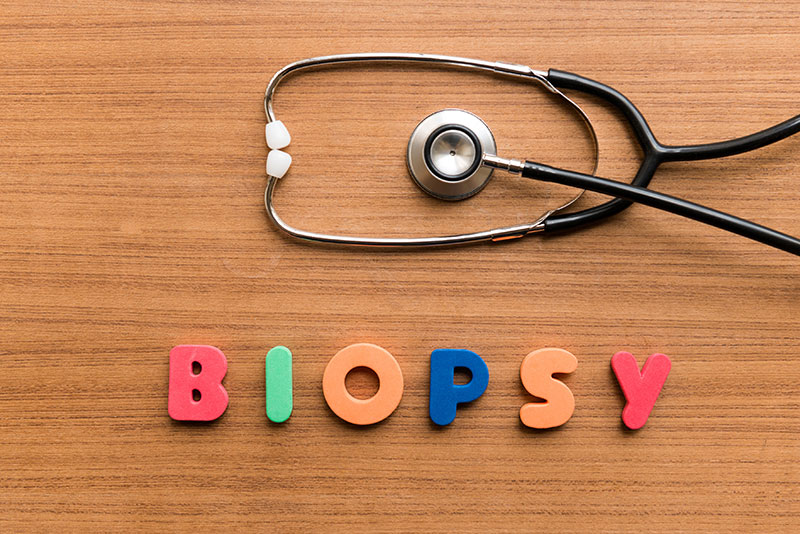Various types of biopsy procedures are used to make a cancer diagnosis such as bone marrow biopsy, endoscopic biopsy, needle biopsy, skin biopsy and surgical biopsy. Providers of biopsy services need to know how to properly bill and code for these procedures and outsourcing medical billing and coding is a practical solution to report them correctly.
CPT Codes For Biopsy Procedures
In 2019, a series of CPT codes for biopsy procedures were introduced which are specific to the method of removal – tangential, punch, and incisional:
11102 Tangential biopsy of skin (e.g., shave, scoop, saucerize, curette); single lesion
+11103 each separate/additional lesion (List separately in addition to code for primary procedure)
11104 Punch biopsy of skin [including simple closure, when performed]; single lesion
+11105 each separate/additional lesion (List separately in addition to code for primary procedure)
11106 Incisional biopsy of skin (e.g., wedge) (including simple closure, when performed); single lesion
+11107 each separate/additional lesion (List separately in addition to code for primary procedure)
Tangential biopsies (codes 11102–11103), are performed with a sharp blade and shave, scoop, saucerization, or curette techniques are used to remove a sample of epidermal tissue, with or without a portion of the underlying dermis.
Punch biopsies (codes 11104–11105) involve using a punch tool to remove a full-thickness cylindrical sample of the skin.
In incisional biopsies (codes 11106–11107), a sharp blade is used to make a vertical incision or wedge to remove a full-thickness sample of tissue, penetrating deep to the dermis and into the subcutaneous space.
Reasons For Denials
Reports indicate improper billing and denials have increased. Medicare Administrative Contractor First Coast Service Options (FCSO) identifies the reasons for biopsy procedure claim denials as:
- When biopsy codes are billed with other surgery codes on the same date of service, modifier 59 (“a distinct procedural service”) is being appended to the other surgery code instead of the biopsy code.
- Biopsy codes exceed the CMS Medically Unlikely Edits (MUEs). An MUE for a HCPCS/CPT code is the maximum units of service that a provider would report under most circumstances for a single beneficiary on a single date of service.
- The wrong primary code is being billed or no primary code is billed at all.
- Biopsy codes are billed with a screening diagnosis.
Prevent Denials For Biopsy Services – Follow These Guidelines
According to AAPC, CPT guidelines on coding biopsy services can throw light on why these codes are facing denials: use of the incisional, punch, and tangential biopsy codes indicates that the procedure was to obtain tissue for “diagnostic histopathologic examination” and that the procedure was “performed independently or was unrelated or distinct from other procedures/services provided at that time.”
To obtain proper payment for biopsy services, follow these steps:
- Report CPT codes 11102-11107 only for diagnostic biopsies and do not bill these codes with a screening diagnosis code.
- Apply the appropriate modifier to the appropriate code. Modifier 59 (distinct procedural service) should be appended to the biopsy code, if applicable. Check National Correct Coding Initiative (NCCI) edits. National Correct Coding Initiative Procedure-to-Procedure (NCCI PTP) edits generally allow a modifier when the biopsy is billed secondary to a major procedure, but most often do not allow a modifier when the biopsy is billed primary to a surgical procedure.
- Report the appropriate primary code. Denials will occur if the wrong primary code is reported or if no primary code is billed.
- Know the rules for reporting multiple biopsies. Biopsy codes can be “mixed and matched” to report biopsy of numerous lesions by various methods (e.g., incisional biopsy of an initial lesion, tangential biopsy of a second lesion). When performing multiple biopsies for the same patient on the same day, use only one primary code. Report the highest-valued code first, without a modifier:
- If multiple biopsies are performed using the same technique, report the primary code with the highest RVU, and use the corresponding add-on code for the other biopsies.
- If multiple biopsies are performed using different techniques, report the primary code with the highest RVU, and append the add-on code specific to the other biopsies done.
- When billing for biopsy services, document the method, the number of units, and the location.
- Ensure that the maximum units of service that can be reported for a single patient on a single date of service is not exceeded. The Centers for Medicare & Medicaid Services’ Medically Unlikely Edits (MUEs) provides the following instructions on this:
- For 11102, 11104, and 11106, only one unit per line item can be billed
- For 11103, 11105, and 11107, multiple units can be submitted on a single line item is allowed.
Primary care providers who perform biopsies can report their services correctly by relying on an experienced family practice medical billing company. Partnering with an expert can help them avoid denials and receive proper and timely payment from Medicare.




